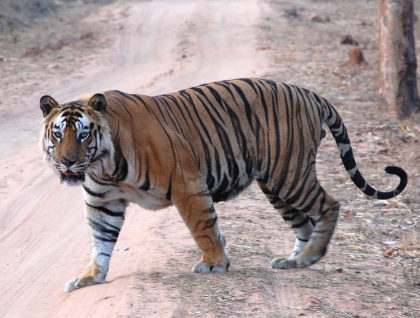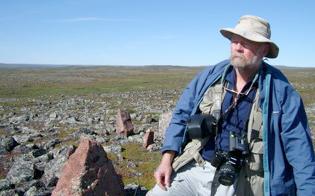
By Bhavna Menon ILCW member (India)
Previously published on her blog.
I first heard of a tiger named Bamera in the summer of 2010, while we were doing a survey in the buffer villages of Bandhavgarh Tiger Reserve. At the time, he had gained notoreity for lifting cattle and had planted a certain degree of fear in the mind of the villagers. “Bahut bada hai sahab, itna bada tiger humne aaj tak nahi dekha” spluttered a villager, a resident of the same village where Bamera got his name from. Located in a beautiful region known as Panpatha, with a huge dam and an ever reaching green landscape, Bamera was as beautiful a tiger and as extravagant as his namesake village.
Very quickly, Bamera made an entry into Bandhavgarh as its dominant male, overthrowing his ageing father – B2. Slated to be the biggest tiger Bandhavgarh had seen for a few years, Bamera coaxed everyones imagination into becoming a stuff of legends among the drivers and guides of the park. “Aree, gadi ke bonnet jitna bada hai” some claimed while others gestured with their hands an un realistic proportion to specify his size and width. But all had one declaration in common- “Bilkul B2 jaisa hai, shant aur shareef.”Dying to sight this fast becoming darling of the forest, I finally saw him in the summer of 2012, during one of our Village Kids’ Awareness Programmes. As soon as we had entered the Tala zone of the park in the sweltering heat, we could sense the sambur’s un easiness. Several hesitant honks and foot stampings later, out he walked ignoring the frenzied Chital and honking Sambur to finally settling down in a pool of water in the Chakradhara meadows. Drinking water at sporadic intervals, he looked around lazily and slowly drifted into a hot summer afternoon nap. As expected, other vehicles rushed in to see him, clamouring with each other to get a better look at him, when one of the drivers laughed and said ” yeh Bamera hai, aaram se dekho, itni jaldi uthne wala nahi hai” and he was right. This trait though, has always been true of Bamera, this calm disposition about him which was a treat to observe. That summer Bamera was quite a show stopper for the kids, appearing regally almost every day, only to be met with gasps and admiration from the children.
The next I saw Bamera was in 2013 and this is perhaps my favourite memory of him. It was when he was playing nanny to the Banbehi cubs and one of the 3 cubs had sought shelter under a lantana bush at Bhitri, refusing to give away its location, resulting in both Bamera and Banbehi frantically looking for it. The “aunh” was very gentle, lazy, half-hearted like a purr almost, urging the cub to come out of hiding, while Banbehi staged impatience by lashing her tail and sniffing the air, as if telling Bamera to get a move on and do a better job of cub hunting. We watched this spectacle, as long as time would permit, unfold with the cub displaying serious tenacity by sticking to its hiding spot, while the parents finally retreated into the hills hoping that their cub would follow. Among other things, Bamera was recognised as a good father and the perfect babysitter, so much so, that Banbehi was known to leave all her three cubs in his care and wander her realm, while Bamera seemed like he was more than happy to be the stay at home father and allow Banbehi to bring home the bacon.
The last I saw of Bamera was in the winter of 2013, when a sudden call by a sambur in the failing evening light, encouraged a race towards Chakradhara. We had just about made it and watched the tiger with the most unhurried of gaits, walk into the tall grass. Everything seemed glorious and rainbow like, but little did I know, that that was probably the last time I was seeing him. Thereon, Bamera’s sightings has only been here say, a tail/glimpse here, a cattle lifting story there, very similar to his mysterious entry into the jungle fold. His exit, with the coming of younger tigers seemed inevitable and soon to be without much suffering, but nature had other things in store. The massive paw that had once decorated the forest floor, had now begun to deteriorate. He finally took very ill in the last 1 year and had to be shifted to an enclosure where he was labelled safe. Safe from the wrath of villagers and younger tigers, but this safety unfortunately deprived people who loved him dearly to get a glimpse of him. But, I guess, in a way I am glad that I didn’t see a deteriorating Bamera. I wouldn’t want to know a deteriorating Bamera and would rather, that my memory playback to him as the golden cat who appeared mysteriously grabbing everyone’s imagination to mewing like a house cat, to the un hurried walk, to the molten stare to leaving massive tracks on the soft, golden sand.
